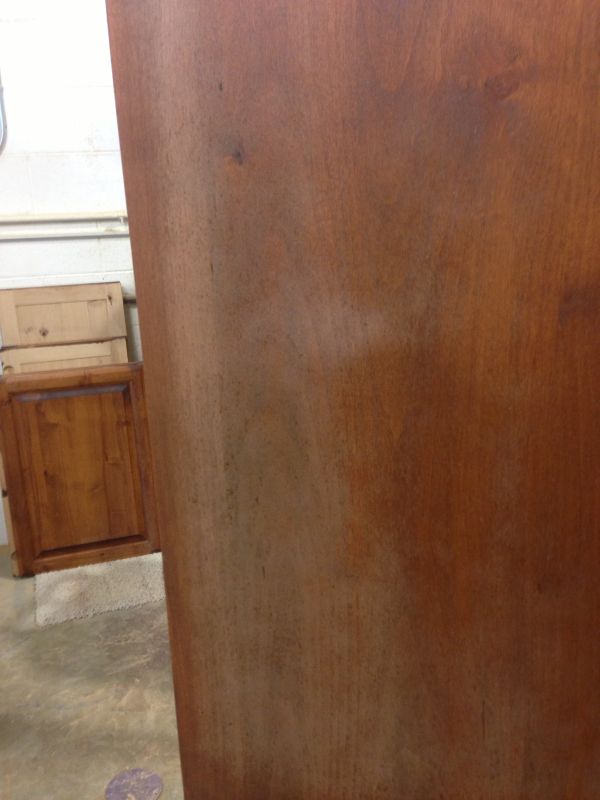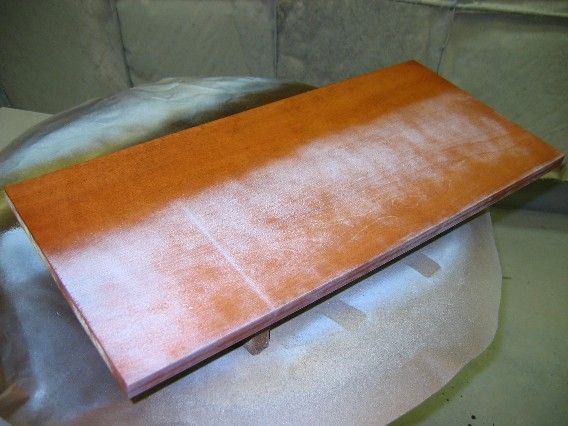Troubleshooting Blush in a Glaze Finish
Finishers offer advice on prevention, and suggest a possible fix for a case of blush. April 24, 2014
Question
WOODWEB Member:
I am using ML Campbell Wood Song II glaze. I reduced it 3 parts glaze and 2 parts mineral spirits. After applying glaze, I let it dry about ten minutes and wiped off until I had the effect I wanted. I let glaze dry for about 1 1/2 and sprayed my vinyl sealer. After sealer dried, I have a white haze. What went wrong and how can I fix it? I did seal my doors after staining and then applied glaze.

Click here for higher quality, full size image
Forum Responses
(Finishing Forum)
From contributor M:
What sealer did you originally use? What did you use to sand or scuff the sealer, prior to the glaze? Why did you thin the glaze with mineral spirits? I always use naphtha. Is there any chance the glaze was not dry? Unfortunately there is no easy solution. You will most likely have to strip and redo. I would just make sure the glaze works and has the desired affect you want before proceeding.
From the original questioner:
How would you suggest I strip it?
From contributor X:
If you are reducing it to make the color lighter, you should reduce it with clear glaze base (same base as the glaze you used) so you won't have compatibility issues.
From contributor J:
If you are going to strip it anyway, you may as well try a few things first. Scuff an area with a pad and spray it with some thinner with a little retarder in it when the humidity is low (checking for moisture blush). If no good, scuff an area and respray it with thinned vinyl somewhat wetter than the first time (checking for poor burn through the glaze layer to the sealer).
I've thinned glazes with mineral spirits since forever and have never had a problem as long as the solvent has fully flashed.
From contributor A:
I am not a user of that particular glaze product, but it seems obvious the excessive amount of mineral spirits in your ratio is the cause. A little MS to extend working time should not be a problem but I agree that for any significant reduction you avoid trouble by using the clear base. That keeps the chemistry of the product consistent even when you want to reduce the pigment load.
It's worth a shot before you strip this to try straight solvent possibly with a little retarder mixed in and mist over the areas and see if the haze may go clear. This would work if it is ordinary blushing due to climate conditions, but your haze is from a different cause, so I am not so optimistic.
From contributor M:
Any commercial grade stripper will work. They generally contain methylene chloride. The higher the percentage, the better. However, you really need to find the cause of that haze - as others have said, it may be blushing. Experiment if you are going to strip it. But I also feel the culprit was the mineral spirits.
From Paul Snyder, forum technical advisor:
Looks like a simple case of blush. Follow contributor J's advice and it will probably fix the problem. I keep some retarder on hand all the time and just mist a very light coat over the blush and watch it disappear.
From Paul Snyder, forum technical advisor:
Here's a picture of a piece of birch plywood with stain and a coat of vinyl sealer on it. The sealer blushed when I applied it, but it doesn't hurt anything. The stripe at the top of the panel that looks normal is where I fogged on some MAK straight out of the can (I don't mix it with other thinner).
When removing blush on lacquer and pre-cats, the amount of retarder I fog on is so slight the surface doesn't look wet. On 2K PU sealer it takes a light wet coat to fix the problem.
If the humidity is high and the temperature is within 20 degrees of the dew point, you may get blush. Air flowing over the piece as it's drying can increase the effect. If you want to avoid it all together, add a little slow evaporating thinner (aka, retarder) to your finish. The tail solvent lets the water vapor escape before the finish dries.

Click here for higher quality, full size image

